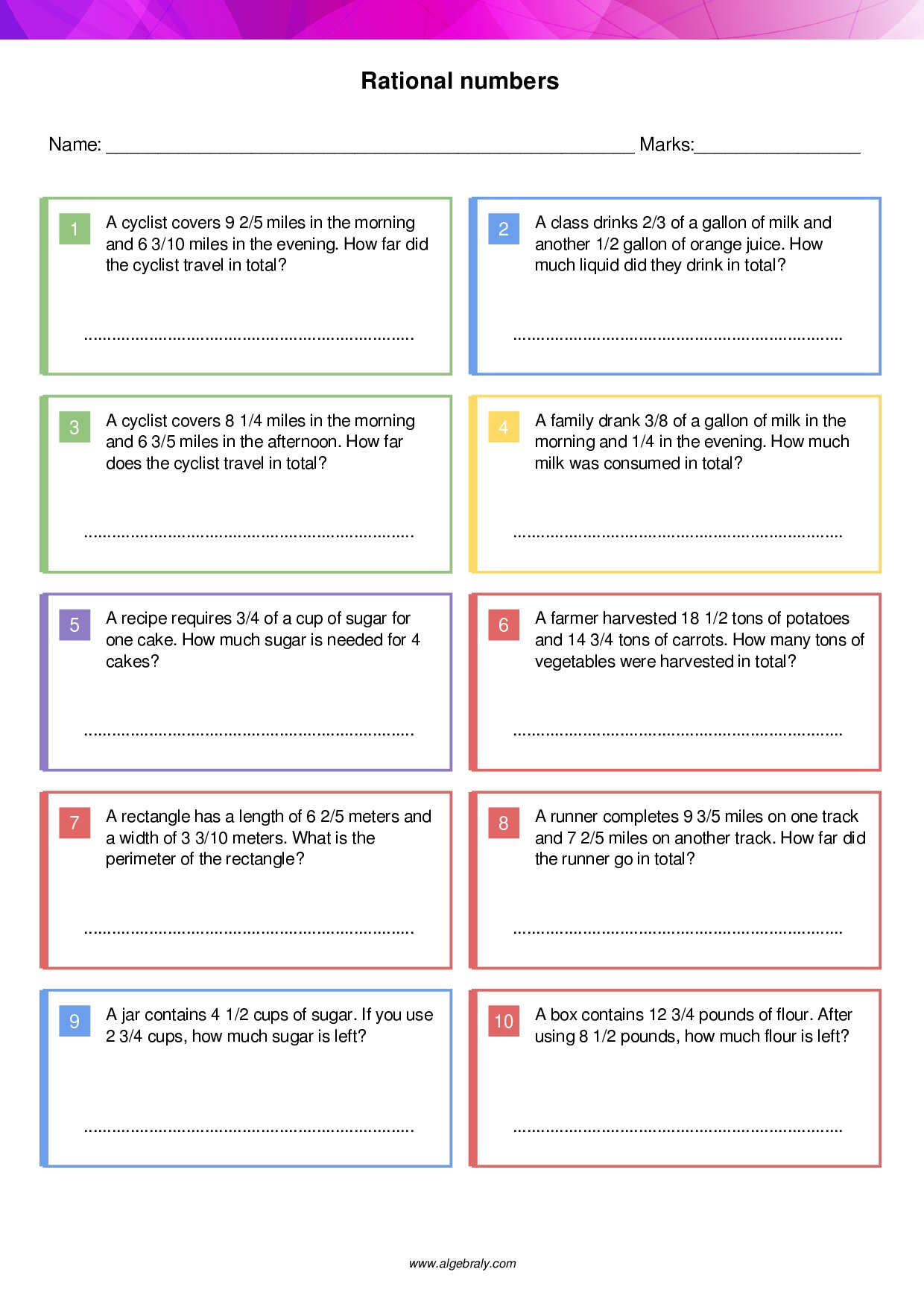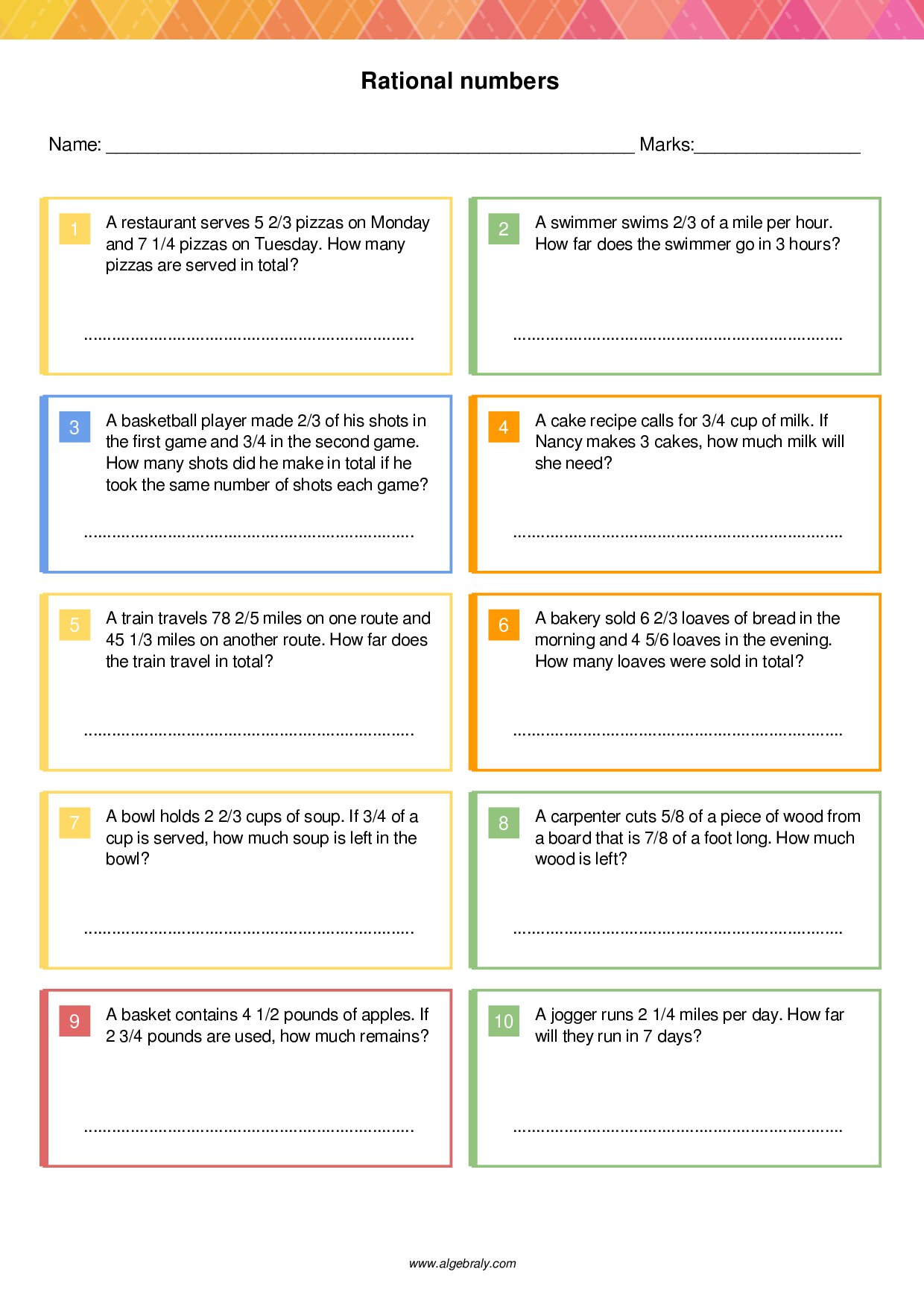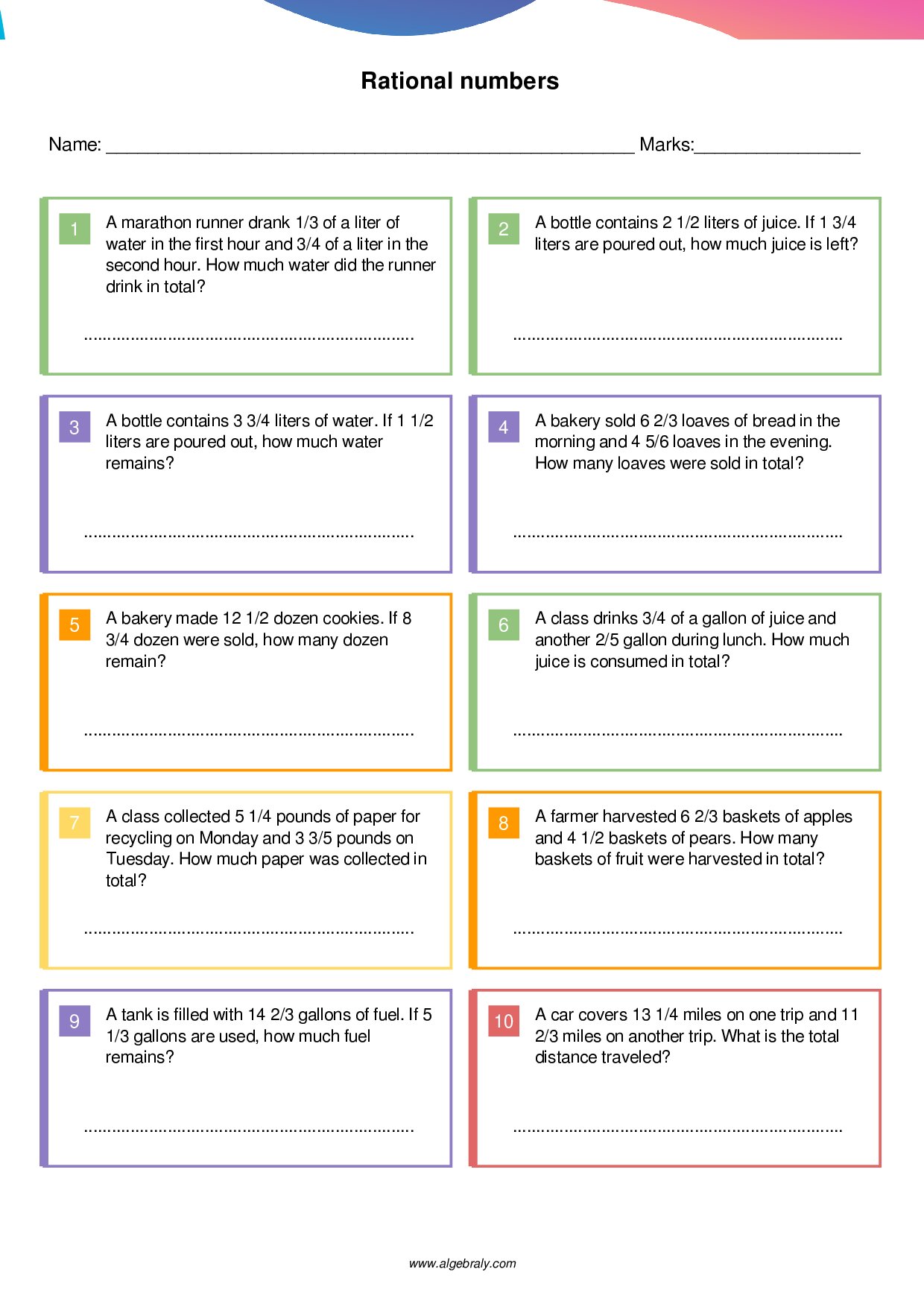Dynamically Generated Operations with Rational Numbers Worksheet
Operations With Rational Numbers Quiz – Word Problems
Maria buys 3/4 of a pound of apples and 1/2 of a pound of bananas. How much fruit did she buy in total?
Find a comprehensive collection of operations with rational numbers worksheets designed to make pre-algebra learning engaging and practical. These worksheets feature 15 carefully crafted word problems in each, covering all four key operations, rational numbers addition, rational numbers subtraction, rational numbers multiplication, and division. Each worksheet is downloadable in PDF format and making it easy for teachers and parents to print and use in the classroom or at home.
Students can also practice through an online test/quiz, offering immediate feedback and an interactive way to improve their understanding. These resources focus on developing essential math skills such as mastering fractions and mixed numbers, problem-solving, critical thinking, and real-world application.
Every worksheet and quiz is tailored to support skill-building in understanding rational numbers, helping students estimate, visualize, and work confidently with fractions in practical contexts. These operations with rational numbers word problems are dynamic and engaging, ensuring students not only practice math but also relate it to everyday scenarios, such as sharing, measuring, or scaling quantities.
Students will get the confidence needed to excel in pre-algebra by using these worksheets and quizzes and help them to prepare for more advanced math concepts. Whether you’re a teacher looking to enhance lesson plans or a parent seeking extra practice for your child, these worksheets and online quizzes are the perfect tools for math success.
Skills Focused: Understanding Rational Numbers, Operations with Rational Numbers, Addition of Rational Numbers, Subtraction of Rational Numbers, Multiplication of Rational Numbers, Division of Rational Numbers, Problem Solving, Critical Thinking, Fractions and Mixed Numbers Mastery, Estimation and Reasonableness, Real-World Applications, Visualization
How to Solve an Operations with Rational Numbers Word Problem
Maria buys 3/4 of a pound of apples and 1/2 of a pound of bananas. How much fruit did she buy in total?
Time needed: 1 minute
Learn how to solve a math problem involving the addition of fractions with different denominators.
- Understand the Problem
Identify the fractions to add: 3/4 for apples and 1/2 for bananas. Determine that the goal is to find the total amount of fruit bought.
- Find the Least Common Denominator (LCD)
Determine the least common denominator of 4 and 2, which is 4.
- Convert Fractions to Have the Same Denominator
Rewrite 1/2 as 2/4 to match the denominator of the other fraction (3/4).
- Add the Fractions
Add the numerators of 3/4 and 2/4 while keeping the denominator the same: 3/4 + 2/4 = 5/4.
- Simplify the Result
Simplify 5/4 to a mixed number: 5/4 = 1 1/4.
- Write the Final Answer
The total amount of fruit bought is 1 1/4 pounds.
Frequently Asked Questions (FAQs)
What are the four operations with rational numbers?
The four operations with rational numbers are addition, subtraction, multiplication, and division. These operations involve fractions, decimals, and mixed numbers, often requiring skills like finding a common denominator, simplifying fractions, and working with reciprocals for division.
How can you add and subtract rational numbers?
To add or subtract rational numbers, first ensure they have a common denominator if you’re working with fractions. For addition, simply add the numerators and keep the denominator the same. For subtraction, subtract the numerators while keeping the denominator constant. Simplify the result if possible.
How do you multiply rational numbers?
Multiplying rational numbers is straightforward. Multiply the numerators to find the new numerator, and multiply the denominators to find the new denominator. Simplify the fraction if necessary. If you’re multiplying mixed numbers, convert them to improper fractions first.
How do you divide rational numbers?
To divide rational numbers, multiply the first fraction by the reciprocal of the second fraction. For mixed numbers, convert them to improper fractions before dividing. Simplify the resulting fraction when possible.
Why is it important to practice operations with rational numbers?
Practicing operations with rational numbers builds a strong foundation for algebra and other advanced math concepts. It also helps in real-life situations, like dividing resources, working with measurements, or calculating rates and proportions.
What are common mistakes when working with rational numbers?
Some common mistakes include not finding a common denominator when adding or subtracting fractions, forgetting to flip the second fraction when dividing, or not simplifying the final answer. Students can avoid these mistakes by paying attention to them.
How do you simplify fractions in rational number operations?
Divide the numerator and denominator by their greatest common divisor (GCD) to simplify fractions. This produe the fraction to its simplest form and making it easier to work with in further calculations.
What real-world examples involve rational numbers?
Rational numbers are used in everyday life, like splitting a bill among friends, scaling recipes, measuring distances, or calculating fuel consumption. They are also essential in finance, engineering, and science.
How do you convert mixed numbers to improper fractions?
To convert a mixed number to an improper fraction, multiply the whole number by the denominator, then add the numerator. Place this result over the original denominator. For example, 4 1/5 becomes 21/5 and 2 3/4 becomes 11/4.
How do you teach operations with rational numbers effectively?
Start with visual aids like fraction models to explain concepts. Gradually introduce rules for operations, and provide plenty of practice problems with step-by-step solutions.
Can rational numbers be negative?
Yes, rational numbers can be negative. For example, -3/4 and -5 are negative rational numbers. The operations work the same way, but you need to keep track of the signs.
What is the difference between a rational number and an irrational number?
A rational number can be expressed as a fraction or a ratio of two integers, like 3/4 or -2. An irrational number cannot be written as a simple fraction; examples include π and √2.
How do you estimate answers when working with rational numbers?
To estimate, round the fractions or decimals to simpler values, like whole numbers or fractions with common denominators. Perform the operation on the rounded numbers to get an approximate answer.
Are decimals rational numbers?
Yes, decimals are rational numbers if they terminate (e.g., 0.75) or repeat (e.g., 0.333…). These can be converted to fractions, making them rational.
What is the best way to check your work with rational number operations?
To check your work, reverse the operation. For example, after adding two fractions, subtract one fraction from the result to see if you get the other. You can also simplify your final answer to verify it’s correct.





